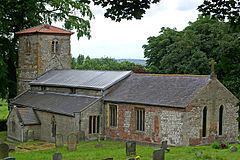OS grid reference TA01982069 Postcode district DN18 | Unitary authority Sovereign state United Kingdom Dialling code 01652 | |
 | ||
Region | ||
Horkstow is a village and civil parish in North Lincolnshire, England, 4 miles (6.4 km) south-west from Barton-Upon-Humber, 1 mile (1.6 km) south from South Ferriby and 9 miles (14.5 km) north from Brigg. It lies on the B1204, and 1 mile (1.6 km) east from the navigable River Ancholme. It is one of the five Low Villages - Worlaby, Bonby, Saxby All Saints, Horkstow and South Ferriby - between Brigg and the River Humber, so-called because of their position below the northern edge of the Lincolnshire Wolds. Horkstow was previously part of South Humberside administrative district, and before that, the North Lindsey division of Lindsey, Lincolnshire.
Contents
- Map of Horkstow Barton upon Humber UK
- Parish church
- Listed buildings
- The Horkstow Roman Pavement
- References
Map of Horkstow, Barton-upon-Humber, UK
In the Domesday account, the village is referred to as "Horchetou", although the name has gone through various changes since.
Parish church
The parish church, built by The Knights Templar in the early 12th century, is dedicated to St Maurice, and is Grade I listed. It has been much rebuilt and restored since establishment; an internal restoration was carried out in 1868, and an external in 1895. Other places of worship were the Primitive Methodist and Wesleyan chapels, now converted to other use.
Listed buildings
Horkstow’s Grade II listed buildings include 17th- and 18th-century barns, and various houses and cottages. Three Horkstow listed buildings, Manor Farmhouse, Horkstow Hall, and Horkstow Grange, are of particular historic note. Charles Gore was born at Horkstow Hall in 1729, he married well and died at Weimar in German high society.
In 1756 artist George Stubbs stayed at Manor Farmhouse to pursue analytical examination and meticulous drawing of horse carcasses acquired from nearby tanneries.
In 1937 Percy Grainger used the traditional Horkstow Grange folk tune as part of his Lincolnshire Posy suite. Historic folk associations with the Grange inspired the Steeleye Span band name, and their album Horkstow Grange.
The Horkstow Roman Pavement
In 1796 three sections of a tessellated Roman mosaic pavement depicting Greek mythological figures were discovered by workmen in the grounds of Horkstow Hall. The pavement was taken to the British Museum in 1927 on permanent loan, but was transferred to Hull Museum in 1974.
